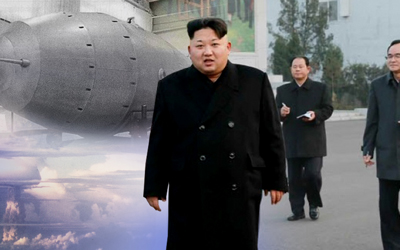- California Assembly OKs highest minimum wage in nation
- S. Korea unveils first graphic cigarette warnings
- US joins with South Korea, Japan in bid to deter North Korea
- LPGA golfer Chun In-gee finally back in action
- S. Korea won’t be top seed in final World Cup qualification round
- US men’s soccer misses 2nd straight Olympics
- US back on track in qualifying with 4-0 win over Guatemala
- High-intensity workout injuries spawn cottage industry
- CDC expands range of Zika mosquitoes into parts of Northeast
- Who knew? ‘The Walking Dead’ is helping families connect
N. Korea could deploy H-bomb around 2020: 38 North

The North’s leader made the H-bomb claims last week, saying the country has become a “powerful nuclear weapons state.” (Yonhap)
By Chang Jae-soon
WASHINGTON (Yonhap) — North Korea’s claims of hydrogen bomb development are technically unlikely for now, but the communist nation could deploy a single-stage thermonuclear weapon with a yield of 100 kilotons by around 2020, a U.S. expert claimed Wednesday.
North Korean leader Kim Jong-un claimed last week that the country has become a “powerful nuclear weapons state ready to detonate a self-reliant A-bomb and H-bomb.” It was believed to be the first time that Kim has publicly claimed development of an hydrogen bomb, which is much more powerful than conventional nuclear weapons.
But the White House effectively rejected the claims, saying U.S. intelligence “calls into serious question those claims.” Officials in Seoul also expressed skepticism, saying Pyongyang is not believed to have such capabilities when it has not yet mastered the technology to miniaturize nuclear warheads.
Joel Wit, editor of the website 38 North, said during a press briefing that the North’s H-bomb claim is “technically unlikely, but boosting yields with fusion fuels is not.” He also said that every country that has built nuclear weapons has done that as next step in the development process.
“Our projection is that by 2020, they could reach the deployment of a single-stage thermonuclear weapon. They could also make significant progress on the two-stage, the larger yield nuclear weapon,” he told reporters.
The 100 kiloton-yield is “quite significant from where we think they are today. We think they’re probably in the area of 10 to 20 kilotons today.” The yield of the nuclear device the North last tested in 2013 was estimated at about 7 kilotons.
Two-stage H-bombs, consisting of a trigger and a secondary, have yields in the megaton area, Wit said.
Wit also said the U.S. should accept the North’s demand for peace treaty negotiations.
Pyongyang has stepped up the demand in recent months as the six-party nuclear talks have long remained stalled. The U.S. has flatly rejected the idea as a nonstarter as long as the North has nuclear ambitions. U.S. officials have stressed that should first focus on negotiations to end its nuclear program.
“Everyone thinks it’s not serious,” Wit said of the North’s demand. “What I would say is let’s find out if they’re serious. Let’s engage them on it. Let’s say to them, ‘Hey sure, peace treaty talks, happy to do it, but you have to address our issues too, denuclearization.’”
The expert said that one of the reasons for the North’s development of nuclear weapons was because the country feels threatened, and one of the ways to address the threat is to formally end the 1950-53 Korean War with a peace treaty.















